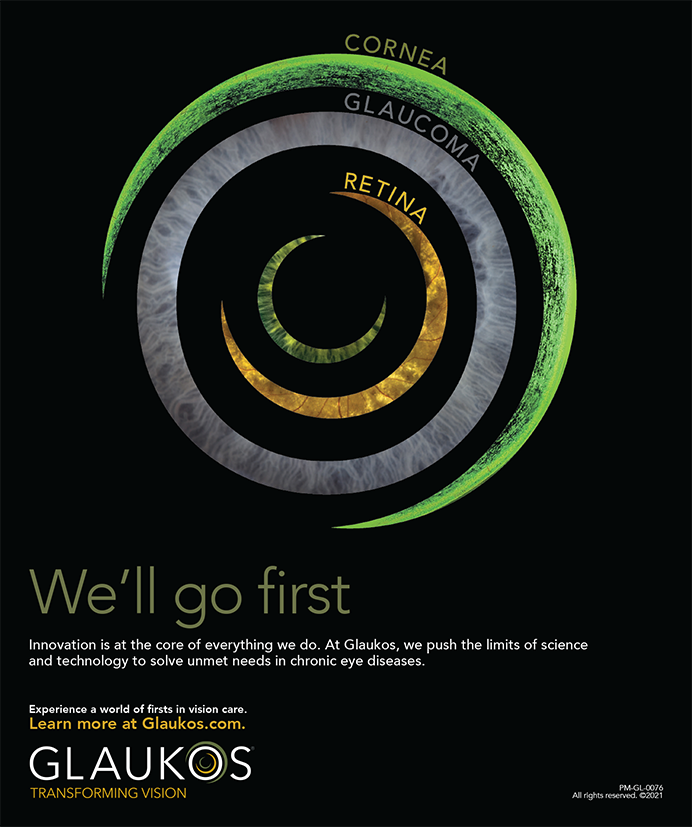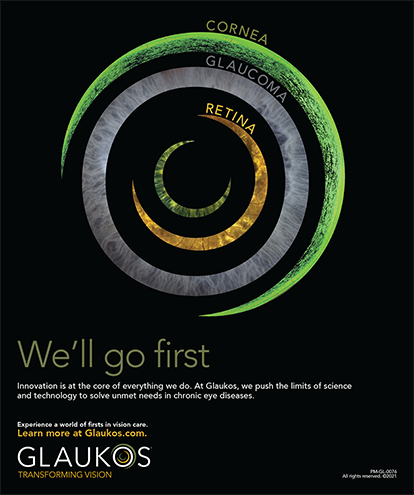Managing concomitant glaucoma and cataract is a common problem for many ophthalmologists. A combined filtration procedure and cataract extraction was developed to reduce the postoperative risk of increased IOP and to improve long-term IOP control.1 In addition, combined phacoemulsification with IOL implantation and trabeculectomy (phacotrabeculectomy) has become the surgical treatment of choice for concomitant glaucoma and cataract,2 and the use of antifibrotic drugs has become increasingly popular for glaucoma surgery, including combined cataract/glaucoma procedures and glaucoma filters. To boost the success rate and pressure-lowering effect of trabeculectomy, antifibrotic agents were used as adjunctive therapy to decrease postoperative scar formation.3 Research has shown that antifibrotic agents, such as mitomycin C (MMC) and 5-fluorouracil (5-FU), improve bleb survival, result in lower postoperative IOP, and decrease the need for long-term glaucoma medications after a trabeculectomy.3,4 The role of antifibrotic agents in combined glaucoma and cataract surgery, however, has not been well defined. This article focuses on the utility of adjunctive antifibrotic agents, such as MMC and 5-FU, in phacotrabeculectomy.
MMC
MMC is an anti-tumor antibiotic isolated from the fermentation filtrate of Streptomyces caespitosus that interrupts DNA replication and inhibits mitosis.3,5 Ophthalmic uses for MMC include pterygium surgery, dacryocystorhinostomy, optic nerve sheath fenestration, and filtration surgery. MMC significantly improves the long-term IOP control in glaucoma patients at higher risk for filtration surgery failure by preventing postoperative scar formation (Figure 1). However, the results from studies analyzing the effect of MMC versus placebo in combined glaucoma and cataract operations have been mixed. Several randomized studies have shown no difference in the effectiveness of phacotrabeculectomy with and without MMC.6,7 Others showed that intraoperative MMC use during phacotrabeculectomy improved the outcome versus placebo and resulted in lower IOPs and a decreased use of anti-glaucoma medication postoperatively.8-10
Complications
Serious complications associated with using MMC as an antifibrotic agent include endophthalmitis, hypotony, maculopathy, and late-onset bleb leaks.2,11-13 Other postoperative problems associated with combined procedures using MMC include choroidal detachment, uveitis, and a shallow anterior chamber.5 Because of these complications associated with MMC, surgeons should use the drug with caution.
Risks
The risk factors for filtration surgery have been identified as (1) black ethnicity, (2) having a preoperative pressure of 20 mm Hg or more on maximum tolerated medication, and (3) taking two or more medications preoperatively.4,7 When adjunctive MMC was used, these three factors were no longer found to be significant indicators of filtration failure. Due to the possibility of serious complications (such as late postoperative hypotony, wound leaks, and endophthalmitis), ophthalmologists should use MMC with caution. Clinically, however, in combined cataract and glaucoma surgery, the bleb is more likely to be elevated and functioning after the intraoperative application of MMC compared with no antifibrotic treatment.
5-FU
By affecting DNA synthesis, 5-FU acts on the S phase of the cell cycle and thereby inhibits fibroblast proliferation.3 Researchers have shown that this antimetabolite reversibly decreases subconjunctival fibroblast proliferation in animal models.12 It can be administered intraoperatively, postoperatively, or both. Figure 2 shows the result after the postoperative injection of 5-FU in a patient. Intraoperative administration of 5-FU was shown to decrease the number of postoperative 5-FU injections required, and this technique resulted in fewer side effects and similar success rates to only postoperative 5-FU injections in trabeculectomy.12 However, we found no studies comparing intraoperative and postoperative 5-FU administration with only postoperative 5-FU for phacotrabeculectomy.
The results of studies analyzing the effect of postoperative 5-FU were mixed. Two randomized placebo-controlled studies1,14 of postoperative 5-FU showed no improved control of IOP 1 year after combined surgery with versus without 5-FU. In each, both groups of patients achieved a similar visual outcome, a decrease in the number of glaucoma medications needed, and improved IOP control. However, another randomized, controlled, clinical trial showed that 5-FU improved the 1-year success rate of phacotrabeculectomy.15 To further complicate the issue, other investigators12 reported that 5-FU improved the success rate of trabeculectomy, but they determined that phacotrabeculectomy with postoperative 5-FU had a lower surgical success rate than trabeculectomy with 5-FU. This study found that phacotrabeculectomy with 5-FU had no statistically different success rate than trabeculectomy without 5-FU.
In addition, researchers analyzing 5-FU versus MMC in a controlled study showed that the 5-FU group's success rates were no better than placebo at all time periods measured over the course of more than 1 year.6 They also found that black patients had a higher failure rate than the rest of the population in phacotrabeculectomies. The results of this study indicated that failures were more common in patients receiving postoperative 5-FU compared with MMC or no antifibrotic, in boththe entire group and in the subgroup of black patients.
Similarly to MMC, the use of 5-FU is associated with several possible adverse effects. They include hypotony maculopathy, endophthalmitis, and bleb leaks.3 Myopia was found to be the primary risk factor for the development of hypotony maculopathy in 5-FU users. In addition, corneal and conjunctival epithelial toxicity has been reported with 5-FU administration. Punctate epithelial erosions, corneal epithelial defects, and primary conjunctival wound leaks are the most common complications of postoperative 5-FU injections.3
ALTERNATE ANTIFIBROtic TREATMENTS
Several promising experimental therapies to watch for in the future include D-penicillamine, beta-aminopropionitrile, B-irradiation, and interferon-alpha 2b. D-penicillamine inhibits collagen maturation. Intraperitoneal and topical D-penicillamine have been used with topical glucocorticoid therapy to increase successful bleb formation in rabbit models with limited success.3 Beta-aminopropionitrile inhibits the initial event in collagen cross-link formation by inhibiting the copper-dependent enzyme lysyl oxidase. Applied topically, it has been used to decrease the strength of scar tissue after glaucoma filtration surgery.3 The long-term efficacy of beta-aminopropionitrile has not yet been established. Research has shown that pre- and postoperative corticosteroid use increases the likelihood of successful glaucoma filtration surgery.3 Interferon-alpha 2b has a beneficial effect, either when used alone or in combination with 5-FU after glaucoma filtration surgery.16 However, interferon-alpha 2b did not offer any additional benefit over current antifibrotic therapy. No one has yet reported that any of these experimental medications has a beneficial effect in phacotrabeculectomy.
CURRENT CLINICAL UTILIZATION
Surgeons use MMC to varying degrees in the clinic; its utilization often depends on the prevalence in their practice of risk factors for the failure of filtration surgery. Clinicians treating patients with more advanced glaucoma with a lower target IOP or patients with risk factors for the failure of filtration surgery frequently tend to use MMC. In our practice, we use MMC in most patients who undergo combined cataract and glaucoma surgery. The dose and exposure time is usually 0.25 to 0.4 mg/cc for 2 to 3 minutes. We use Weck-cel sponge fragments (Medtronic Solan, Jacksonville, FL), but merocel, gelfoam, filter paper, or other absorbent materials may be used. We also use postoperative 5-FU adjunctively in some patients, particularly those with focal inflammation around the bleb or an encapsulating bleb. The usual single dose of 5-FU is 5 mg/0.1 cc injected subconjunctivally. The 5-FU may be repeatedly administered over the next few weeks, up to a total dose of approximately 15 to 25 mg. Sometimes we administer additional 5-FU to patients who have had MMC intraoperatively, and, in other instances, we give 5-FU injections to patients who have not had MMC.
CONCLUSION
Currently, MMC and 5-FU are the principal antifibrosis drugs used to increase the success of phacotrabeculectomy. Many physicians are using MMC in their patients because of the evidence that MMC benefits trabeculectomy. Although MMC may improve success rates and achieve lower postoperative IOPs in many patients, this drug has been associated with serious late postoperative complications, which suggests that practitioners should use the drug cautiously. 5-FU is not as effective as MMC, but this drug may be used postoperatively in failing blebs after trabeculectomy.
Adel M. Al-Jazzaf, MD, FRCS, is a fellow at the Department of Ophthalmology at the University of Tennessee Health Science Center in Memphis, Tennessee.
Address correspondence to Peter A. Netland, MD, PhD, Professor and Director of Glaucoma at the Department of Ophthalmology, University of Tennessee Health Science Center in Memphis, Tennessee. Dr. Netland may be reached at (901) 448-5883; msmith@mail.utmem.edu.
1. O'Grady JM, Juzych MS, Shin DH, et al. Trabeculectomy, phacoemulsification, and posterior chamber lens implantation with and without 5-fluorouracil. Am J Ophthalmol. November 1993;116:594-599.
2. Casson RJ, Salmon JF. Combined surgery in the treatment of patients with cataract and primary open-angle glaucoma. J Cataract Refractive Surg. November 2001;27:1854-1863.
3. Parrish RK, Folberg R. Wound healing in glaucoma surgery. In: Ritch R, Shields MB, Krupin T, eds. The Glaucomas. Volume III. 2nd ed. St. Louis, MO: Mosby; 1996:1636-1645.
4. Heffelfinger BL, Berman MN, Krupin T, et al. Surgical management of coexisting glaucoma and cataract. Ophthalmol Clin N Am. 2000;3(3):545-30A.
5. Costa VP, Moster MR, Wilson RP, et al. Effects of topical mitomycin C on primary trabeculectomies and combined procedures. Br J Ophthalmol. 1993;77(11):693-697.
6. Budenz DL, Pyfer M, Singh K, et al. Comparison of phacotrabeculectomy with 5-fluorouracil, mitomycin-C, and without antifibrotic agents. Ophthalmic Surgery and Lasers. 1999;30(5):367-374.
7. Shin DH, Ren J, Juzych MS, et al. Primary glaucoma triple procedure in patients with primary open-angle glaucoma: The effect of mitomycin C in patients with and without prognostic factors for filtration failure. Am J Ophthalmol. 1998;125(3):346-352.
8. Cohen JS, Greff LJ, Novack GD, Wind BE. A placebo-controlled, double-masked evaluation of mitomycin C in combined glaucoma and cataract procedures. Ophthalmology. 1996;103(11):1934-1942.
9. Carlson DW, Alward WLM, Barad JP, et al. A randomized study of mitomycin augmentation in combined phacoemulsification and trabeculectomy. Ophthalmology. 1997;104 (4):719-724.
10. Shin DH, Vandenbelt SM, Kim PH, et al. Comparison of long-term incidence of posterior capsilar opacification between phacoemulsification and phacotrabeculectomy. Am J Ophthalmol. 2002;133(1):40-47.
11. Zacharia PT, Schuman JS. Combined phacoemulsification and trabeculectomy with mitomycin-C. Ophthalmic Surgery and Lasers. 1997;28 (9):739-744.
12. Singh RP, Goldberg I, Mohsin M. The efficacy and safety of intraoperative and/or postoperative 5-fluorouracil in trabeculectomy and phacotrabeculectomy. Clin Exper Ophthalmol. 2001;29 (5):296-302.
13. Greenfield DS, Suner IJ, Miller MP, et al. Endophthalmitis after filtering surgery with mitomycin. Arch Ophthalmol. 1996;114: 943-949.
14. Wong PC, Ruderman JM, Krupin T, et al. 5-fluorouracil after primary combined filtration surgery. Am J Ophthalmol. 1994;117 (2):149-154.
15. Gandolfi SA, Vecchi M. 5-fluorouracil in combined trabeculectomy and clear-cornea phacoemulsification with posterior chamber intraocular lens implantation. Ophthalmology. 1997;104(2):181-186.
16. Gillies MC, Brooks AM, Young S, et al. A randomized phase II trial of interferon-alpha2b versus 5-fluorouracil after trabeculectomy. Aust NZ J Ophthalmol. 1999;27(1):37-44.


